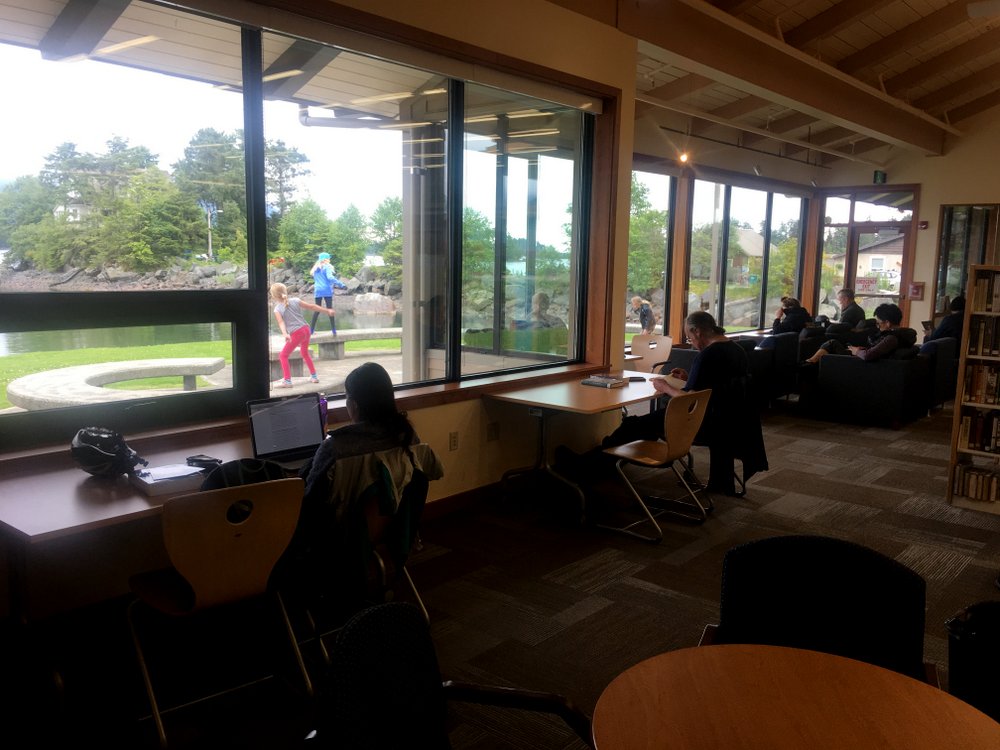
Glass is often the enemy of high performance, but the windows in Sitka’s Public Library are “the best that money can buy,” says architect Paul Voelkers. Triple-glazed, fiberglass frames, with high-tech coatings to reflect heat back into the building. (KCAW folder/Robert Woolsey)
Two years after opening, Sitka’s newly-renovated public library has proven to be the most energy-efficient library in Alaska — and it even tops libraries in Washington state.
The Sitka Public Library and two other recently remodeled buildings in Sitka — Harrigan Centennial Hall and the Sitka Ranger District headquarters — were featured in the summer issue of the magazine “High Performance Buildings.”
Of the three, the library scored the highest marks — a noteworthy achievement since energy efficiency was not the building’s foremost design consideration.
KCAW’s Robert Woolsey met the renovation’s architect, Paul Voelckers, in the library stacks to discuss why the project turned out so well.
KCAW — So here we are talking in a place where we’re not allowed to talk.
Voelkers — Exactly. We’ll be very muted and scholarly.
KCAW — As an architect, is it a headache when somebody tells you they want both an energy-efficient building and a lot of glass?
Voelkers — Well that really is the central question, and I would say this building — especially as the city and users articulated what they wanted in the building — was about the view, the setting, the friendliness for the using public. So one of the things we’re most proud about with this having a high energy performance as tested, is that wasn’t really the driving issue. The City & Borough of course want to have an efficient building, and that had been one of the things that prompted studies for new expansion was to try to get some of their operating costs down. They were reaching the point where the old building had both maintenance issues — with gutters that were leaking, and siding that needed to be replaced, and a roof that was starting to leak a little bit — but also fairly high background operating costs. So they were hoping that a renovation would address that. But it wasn’t the central thing. If you started with engineering, the central issue wasn’t about an engineering solution, but to really keep the visibility and the quality of the site foremost.

Paul Voelkers, with MRV Architects in Juneau, shows the two air-source heat pumps which warm the library’s floor by extracting heat from the outside air. “This used to be where the fuel tanks were,” he says. “Now there’s this Japanese screen.” (KCAW photo/Robert Woolsey)
KCAW — There is a lot of daylight in here, but the energy features are not obvious.
Voelkers — Right. And philosophically that’s exactly right. As we get smarter and better about energy solutions they should not be a big, extroverted solution. They become a background part of the solution. And so things like envelope: the windows, the roof — those things have gotten much better in the last 10 or 15 years, and I think the architects and the engineers have gotten better at integrating high performance as a given, not as some exotic, special thing that you want to do. And as you look around the room, if you compared this layout with what was here five years ago, a conspicuous difference to me is that you don’t have big, giant ducts anymore. One of the things that’s been very successful in this building — and we should credit the mechanical engineers, a group called Ecotope from Seattle, very progressive, they’ve done a deep think over how much ventilation you really need. And we tend to overventilate spaces, which means you heat the air up and throw it away. So you can see a couple of button diffusers in the sidewall — that used to be a duct, literally 30 inches in diameter, with heavy fan noise that you could hear that ventilated this room. So now it’s quiet, almost no air blowing around. There’s enough, so that it’s still a comfortable space, and then they augment it with these small fans, which are very efficient for moving air around without using ducted, conventional systems.
In addition to triple-glazed windows, and super insulation in the roof and floor slab, the library owes its energy success to a pair of airsource heat pumps to produce hot water that is circulated through the floor. Engineering for the heating system was designed by Ecotope in Seattle.






























